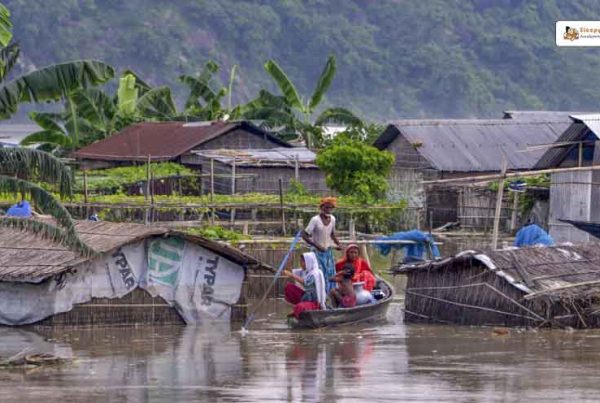National Waterways in India are like the veins of the country, helping in connecting different regions and promoting trade. These waterways are essential for moving goods and people efficiently. The government has created a network of these water highways to make transportation easier and to boost the economy. This article explores the history, major waterways, economic impact, environmental benefits, challenges, technological innovations, government initiatives, case studies, future prospects, regional development, and public-private partnerships involved in the development of National Waterways in India.
Key Takeaways
- National Waterways in India are crucial for connecting different regions and boosting trade.
- The government has developed a network of these waterways to improve transportation efficiency.
- Environmental benefits include reduced carbon emissions and less traffic congestion.
- Challenges like infrastructure limitations and regulatory hurdles need to be addressed.
- Future prospects include new projects and international collaborations.
Historical Development of National Waterways
Early Initiatives
The idea of using rivers for transportation in India dates back to ancient times. Early civilizations, like those along the Indus and Ganges rivers, relied on waterways for trade and travel. However, it wasn’t until the British colonial period that systematic efforts were made to develop inland water transport. The British recognized the potential of rivers for moving goods and established several river ports and navigation routes.
Legislative Framework
Post-independence, the Indian government took steps to formalize the development of national waterways. The Inland Waterways Authority of India (IWAI) was established in 1986 to oversee the development and regulation of inland waterways. The National Waterways Act, 2016 was a significant milestone, designating 111 waterways as national waterways. This act aimed to enhance connectivity and promote the use of inland water transport.
Modern Developments
In recent years, there has been a renewed focus on developing national waterways. The government has launched several initiatives to improve infrastructure and boost cargo movement. For instance, the cargo movement on National Waterway-1 has witnessed significant growth, achieving a 152.75% increase in 2023-24. Modern technologies, such as GPS-based navigation systems, are being integrated to enhance safety and efficiency. The development of these waterways is expected to reduce congestion on roads and railways, providing a cost-effective and eco-friendly mode of transport.
The development of national waterways in India is not just about improving transportation; it’s about connecting remote regions, boosting trade, and promoting balanced economic growth across the country.
Major National Waterways in India
India has a vast network of rivers, canals, backwaters, and creeks that form its inland waterways. These waterways are crucial for transportation and trade. The government has declared 111 national waterways to enhance transportation efficiency and boost trade. National Waterway 1 is the longest and most significant, stretching from Haldia to Allahabad. It covers the Ganges-Bhagirathi-Hooghly river system. This waterway is vital for cargo and passenger transport.
National Waterway 1
National Waterway 1, also known as the Ganga-Bhagirathi-Hooghly River System, is the longest national waterway in India. It spans 1,620 kilometers from Haldia in West Bengal to Allahabad in Uttar Pradesh. This waterway is essential for transporting goods and passengers, and it plays a significant role in boosting trade and commerce in the region.
National Waterway 2
National Waterway 2 covers the Brahmaputra River from Dhubri to Sadiya in Assam. It stretches over 891 kilometers and is crucial for the transportation of goods in the northeastern region of India. This waterway helps connect remote areas and promotes economic development in Assam.
National Waterway 3
National Waterway 3 runs through the West Coast Canal, Champakara Canal, and Udyogmandal Canal in Kerala. It covers a distance of 205 kilometers from Kottapuram to Kollam. This waterway is vital for the transportation of goods and passengers in the state of Kerala, and it supports the local economy by facilitating trade and commerce.
Economic Impact of National Waterways
Boost to Trade
With National Waterways in place, it becomes easier for businesses to trade goods between different regions. This enhanced connectivity leads to economic growth as products can reach various markets faster and at lower costs. It also helps in creating more job opportunities in the shipping and logistics sectors.
Employment Generation
National Waterways in India have become the lifelines of progress, connecting the diverse regions of this vast country. With the aim of enhancing transportation efficiency and boosting trade, the government developed and maintained a network of water highways known as National Waterways in India. To boost Inland Water Transport (IWT) in India, the National Waterways Act, 2016, effective
Cost Efficiency
Despite these challenges, the future prospects for National Waterways in India are promising. The government is investing in
infrastructure and technology to improve the efficiency and safety of these water highways. The development of more waterways is
also underway to connect remote regions and promote balanced economic growth across the country.
Environmental Benefits of Inland Water Transport
Reduction in Carbon Emissions
Inland water transport is a greener alternative compared to road and rail transport. Ships produce fewer engine deposits and require less lubricants, which reduces the risk of contaminants entering waterways. This mode of transport helps in cutting down carbon emissions significantly, contributing to a cleaner environment.
Conservation of Energy
Waterways are more energy-efficient than other forms of transport. They consume less fuel per ton of cargo moved, making them a sustainable choice. This conservation of energy is crucial for reducing our overall carbon footprint and promoting sustainable inland waterway transport development.
Minimizing Traffic Congestion
Using waterways helps in reducing traffic congestion on roads and railways. This not only eases the burden on existing infrastructure but also leads to fewer accidents and lower maintenance costs. By diverting cargo to waterways, we can achieve a more balanced and efficient transportation system.
Inland water transport offers a sustainable and efficient way to move goods, benefiting both the environment and the economy.
Challenges in Developing National Waterways
Infrastructure Limitations
Developing national waterways in India faces significant infrastructure limitations. Many waterways lack the necessary ports, terminals, and navigational aids. This makes it difficult for large vessels to operate efficiently. Additionally, the existing infrastructure often requires extensive upgrades to meet modern standards.
Environmental Concerns
Environmental concerns are another major challenge. The construction and maintenance of waterways can disrupt local ecosystems and wildlife. There is also the risk of water pollution from increased vessel traffic. Addressing these concerns requires careful planning and sustainable practices.
Regulatory Hurdles
Navigating the regulatory landscape is often complex. Multiple agencies and overlapping jurisdictions can slow down the approval process for new projects. Streamlining these regulations is essential for faster development. Moreover, compliance with environmental and safety standards adds another layer of complexity.
Addressing geographical challenges through sustainable infrastructure development, river training works, and effective water resource management can unlock the full potential of India’s national waterways.
Technological Innovations in Waterway Transport
India’s national waterways have seen significant technological advancements, making them more efficient and safer. These innovations are crucial for enhancing the country’s inland water transport system.
Navigation Systems
Modern navigation systems have been introduced to ensure safe and efficient travel on national waterways. These systems include GPS and real-time tracking, which help in monitoring the movement of vessels and avoiding accidents. By enhancing India’s national waterways, these technologies aim to boost the overall efficiency of water transport.
Cargo Handling
Advanced cargo handling technologies have been implemented to streamline the loading and unloading processes. Automated cranes and conveyor systems are now used at various ports, reducing the time and labor required for these tasks. This not only speeds up the process but also minimizes the risk of damage to goods.
Safety Measures
Safety is a top priority in waterway transport. New safety measures, such as automated distress signals and emergency response systems, have been put in place. These innovations ensure that help can be quickly dispatched in case of an emergency, making waterway transport safer for both passengers and cargo.
The Ministry of Ports, Shipping, and Waterways (MoPSW) is committed to developing a robust inland water transport system. By integrating modern technologies, MoPSW aims to make India’s waterways a reliable and efficient mode of transport.
Government Initiatives and Policies
The National Waterways Act, 2016, was a significant step in promoting inland water transport in India. This act declared 111 rivers and river stretches as National Waterways. This move aimed to boost the use of waterways for cargo and passenger transport, reducing the burden on road and rail networks. The act also provided a framework for the development and regulation of these waterways, ensuring their efficient and sustainable use.
The Jal Marg Vikas Project (JMVP) is an ambitious initiative aimed at developing the stretch of the Ganga River between Varanasi and Haldia. This project focuses on improving the navigability of the river, enabling the smooth movement of large vessels. Key components of the project include the construction of terminals, river information systems, and navigational aids. The JMVP is expected to significantly enhance the capacity and efficiency of the National Waterway 1, facilitating trade and commerce.
The Inland Waterways Authority of India (IWAI) is the apex body responsible for the development and regulation of inland waterways in India. Established in 1986, the IWAI plays a crucial role in implementing government policies and initiatives related to waterways. The authority oversees the maintenance and development of infrastructure, ensuring the smooth operation of national waterways. The IWAI also collaborates with various stakeholders, including the Ministry of Ports, Shipping, and Waterways, to promote the use of inland water transport.
Case Studies of Successful Waterways
The Ganga-Bhagirathi-Hooghly River System, also known as National Waterway 1, is one of the most important waterways in India. It stretches from Prayagraj to Haldia, covering a distance of 1,620 kilometers. This waterway passes through the states of Uttar Pradesh, Bihar, Jharkhand, and West Bengal. It plays a crucial role in connecting the eastern and northern parts of India, facilitating the movement of cargo and passengers. The development of this waterway has significantly boosted trade and commerce in the region.
National Waterway 2, which runs along the Brahmaputra River, is another vital waterway in India. It extends from Sadiya to Dhubri, covering a distance of 891 kilometers. This waterway is essential for the northeastern states, providing a lifeline for transportation and trade. The Brahmaputra River System has helped in reducing transportation costs and time, making it a preferred mode of transport for many businesses in the region.
The West Coast Canal, also known as National Waterway 3, is located in the state of Kerala. It stretches from Kollam to Kottapuram, covering a distance of 365 kilometers. This waterway includes the Champakara and Udyogmandal canals. The West Coast Canal is known for its scenic beauty and is a popular route for both cargo and passenger vessels. The development of this waterway has not only improved transportation but also boosted tourism in the region.
The success of these waterways highlights the potential of inland water transport in India. With proper management and investment, these waterways can continue to play a significant role in the country’s economic growth and development.
Future Prospects and Developments
Upcoming Projects
The future of national waterways in India looks bright with several upcoming projects. The government has unveiled a five-year action plan for developing new national waterways. These projects aim to facilitate freight movement and improve connectivity across the country. New waterways will connect remote regions, promoting balanced economic growth.
Investment Opportunities
Investment in national waterways is expected to grow. The government is encouraging both public and private investments to boost infrastructure and technology. This will not only improve the efficiency of water transport but also create numerous job opportunities. Investors can look forward to a promising return on investment as the demand for waterway transport increases.
International Collaborations
India is also looking at international collaborations to enhance its waterway infrastructure. Partnerships with countries experienced in water transport can bring in advanced technology and expertise. These collaborations will help in the faster development of waterways and ensure they meet global standards.
The future of national waterways in India is promising, with significant investments and international collaborations paving the way for a more connected and economically balanced country.
Role of National Waterways in Regional Development
Connecting Remote Areas
National waterways play a crucial role in connecting remote areas that are otherwise difficult to access. This improved connectivity helps in the movement of goods and people, making it easier for businesses to trade and for communities to access essential services. Enhanced connectivity leads to economic growth and better quality of life for people living in these regions.
Promoting Tourism
Waterways also have a significant impact on tourism. They offer unique opportunities for recreational activities such as boating, cruises, and water sports. These activities attract tourists, which in turn boosts the local economy. The scenic beauty along the waterways adds to the appeal, making them popular destinations for both domestic and international tourists.
Facilitating Agriculture
National waterways are vital for the agricultural sector. They provide an efficient means of transporting agricultural produce from farms to markets. This not only reduces transportation costs but also ensures that products reach markets faster, maintaining their freshness and quality. Farmers benefit from better prices and reduced spoilage, contributing to the overall growth of the agricultural sector.
The development of national waterways has the potential to transform regional economies by improving connectivity, boosting tourism, and supporting agriculture. This holistic approach to development ensures that even the most remote areas can participate in and benefit from economic growth.
Public-Private Partnerships in Waterway Development
Collaborative Projects
Public-Private Partnerships (PPPs) have been crucial in the development of India’s national waterways. These partnerships bring together the strengths of both sectors to build the necessary infrastructure. For instance, the Inland Waterways Authority of India (IWAI) has collaborated with private firms to design state-of-the-art vessels for cargo and passenger transport. Such collaborations help in navigating complex river systems like the Ganges, ensuring efficient and safe transport.
Funding Mechanisms
Funding for waterway projects often comes from a mix of public and private investments. The government provides initial funding and regulatory support, while private companies bring in additional capital and expertise. This shared investment model reduces the financial burden on the government and accelerates project completion. The World Bank has also assisted in funding, particularly for the Varanasi-Haldia stretch of National Waterway 1.
Success Stories
There are several success stories of PPPs in waterway development. One notable example is the development of National Waterway 1, where the IWAI and private firms worked together to overcome challenges like acute bends and strong currents. This collaboration has not only improved cargo transport but also boosted local economies by creating jobs and reducing transportation costs.
Public-Private Partnerships are essential for the sustainable development of national waterways, offering a balanced approach to funding and expertise.
Public-Private Partnerships (PPPs) are changing the way we develop our waterways. These collaborations bring together the best of both worlds: the efficiency of private companies and the resources of the public sector. By working together, they can create better infrastructure and services for everyone. Want to learn more about how PPPs are making a difference? Visit our website for in-depth articles and updates.
Conclusion
National Waterways in India are playing a crucial role in connecting different parts of the country and boosting trade. The government’s efforts to develop and maintain these water highways have led to significant improvements in transportation efficiency. With ongoing investments in infrastructure and technology, the future of India’s National Waterways looks promising. These waterways not only support cargo movement but also offer potential for passenger travel, contributing to balanced economic growth across the nation.
Frequently Asked Questions
What are National Waterways?
National Waterways are routes on rivers and canals used for transporting goods and people. They help in moving cargo and passengers efficiently across different parts of the country.
How many National Waterways are there in India?
India has 111 National Waterways. These were established to improve inland water transport and connect various regions.
Which are the major National Waterways in India?
The major National Waterways include NW-1 (Ganga-Bhagirathi-Hooghly river system), NW-2 (Brahmaputra river), and NW-3 (West Coast Canal). These are fully operational and play a key role in transportation.
What is the National Waterways Act, 2016?
The National Waterways Act, 2016, is a law that declared 111 rivers and canals as National Waterways to boost inland water transport in India.
How do National Waterways benefit the economy?
National Waterways help in reducing transportation costs, boosting trade, creating jobs, and connecting remote areas, thus contributing to economic growth.
What are the environmental benefits of using National Waterways?
Using National Waterways helps in reducing carbon emissions, conserving energy, and reducing traffic congestion on roads.
What challenges do National Waterways face?
Some challenges include infrastructure limitations, environmental concerns, and regulatory hurdles that need to be addressed for effective functioning.
What is the future of National Waterways in India?
The future looks promising with ongoing investments in infrastructure and technology. New projects are being developed to connect more regions and enhance transportation efficiency.






